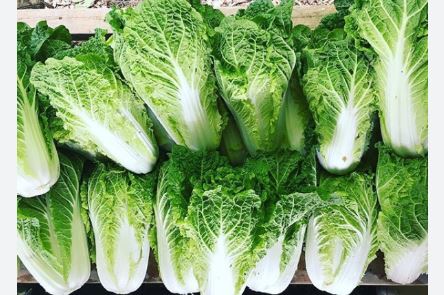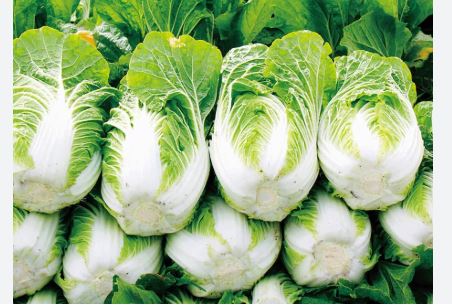
Botanical Classification
Napa cabbage, scientifically classified as Brassica rapa subsp. pekinensis, belongs to the Brassicaceae family, which includes cruciferous vegetables such as broccoli, kale, and turnips. Unlike Brassica oleracea cabbages (e.g., green or savoy), Napa cabbage is derived from the Brassica rapa species, closely related to bok choy and Chinese mustard greens.
The pekinensis subspecies denotes its characteristic elongated, loosely packed heads, distinguishing it from other brassicas. Its botanical lineage ties it to wild turnips, domesticated in East Asia for its tender leaves and crisp stalks, making it a staple in Asian cuisines.
Origin and History
Napa cabbage, also known as Chinese cabbage or celery cabbage, originated in China, with evidence of its cultivation dating back over 1,500 years in the Yangtze River Delta. It was bred for its mild flavor and succulent texture, becoming integral to Chinese cuisine, particularly in northern regions like Beijing (hence pekinensis).
By the 14th century, it spread to Korea and Japan, where it became a key ingredient in dishes like kimchi and nabe. Chinese immigrants introduced Napa cabbage to the United States in the 19th century, and its popularity grew in the 20th century with the rise of Asian-American cuisine. Today, it’s widely grown in states like California and Florida, fueled by demand in Asian markets and mainstream supermarkets.
Identifying Characteristics

Napa cabbage is characterized by its elongated, barrel-shaped heads, typically 10-18 inches long, with loosely packed, pale green to yellowish leaves and thick, white ribs. The leaves are tender, crinkled, and slightly fuzzy, with a crisp, juicy texture, contrasting with the denser heads of green cabbage.
Its compact, cylindrical form and vibrant coloration make it visually distinct. The inner leaves are often creamy white, protected by outer layers, giving it a celery-like appearance, which inspired its alternate name. Napa cabbage’s soft texture and mild nature set it apart from other brassicas in U.S. markets.
Taste
Napa cabbage has a mild, sweet, and subtly peppery taste with a fresh, grassy undertone, less pungent than other cabbages. Its leaves are tender and juicy, with a crisp, celery-like crunch in the ribs, making it ideal for raw preparations. When cooked, it softens quickly, developing a delicate, slightly sweet flavor that absorbs seasonings well.
Unlike green cabbage’s robust bitterness, Napa cabbage’s gentle taste suits quick-cooking methods like stir-frying or fermenting, as seen in kimchi, making it a versatile ingredient in both Asian and fusion cuisines across the USA.
Seasons/Availability
Napa cabbage is a cool-season crop, thriving in temperatures between 7-24°C (45-75°F), with frost tolerance down to -4°C (25°F). In the USA, it’s planted in early spring (February-March) or late summer (July-August), maturing in 50-70 days, and is typically available from late spring (April-May) through early winter (November-December).
It grows well in USDA zones 2-11, with major production in California, Florida, and New Jersey, where Asian vegetable demand is high. Peak availability occurs in fall, but year-round supply is common in U.S. supermarkets, Asian grocers, and farmers’ markets due to greenhouse cultivation and imports, sold fresh or occasionally pre-chopped.
Culinary Uses
Napa cabbage’s tender leaves and crisp ribs make it a cornerstone of Asian-American cuisine. Raw, it’s sliced for salads, slaws, or wraps, pairing well with sesame dressings or citrus, popular in health-conscious recipes. It’s the star of Korean kimchi, fermented with chili and garlic, and Japanese pickles.
Cooked, Napa cabbage is stir-fried with ginger and soy sauce, added to soups like Chinese hot pot or Japanese nabe, or steamed as a side. Its quick-cooking nature suits dumplings and spring rolls, while its mild flavor complements bold ingredients like pork or mushrooms. In the U.S., it’s increasingly used in fusion dishes, from tacos to grain bowls, showcasing its versatility.
Nutritional Value
Napa cabbage is a nutrient-dense vegetable, low in calories (about 16 per cup raw) and rich in vitamins, minerals, and antioxidants. It’s an excellent source of vitamin C (45% of daily needs per cup), supporting immune health, and provides significant vitamin K and folate for blood clotting and cell function.
It contains 1-2 grams of fiber per cup, aiding digestion, and is high in calcium, potassium, and magnesium for bone and heart health. Antioxidants like glucosinolates and sulforaphane offer anti-inflammatory and potential cancer-preventive benefits. Napa cabbage’s high water content and low calorie density make it a valuable addition to weight-conscious and plant-based diets in the USA.
Cultivation of Napa Cabbage (Chinese Cabbage)
- Climate and Season: Napa cabbage thrives in cool weather, with optimal temperatures between 7-24°C (45-75°F), and tolerates light frosts down to -4°C (25°F). Plant in early spring (February-March) or late summer (July-August) for spring and fall harvests. It grows in USDA zones 2-11, with year-round cultivation in mild areas like coastal California and peak fall harvests in cooler regions like New York.
- Site Selection: Choose a site with full sun (6-8 hours daily) for robust head formation, though partial shade is tolerated in warmer states like Florida or Texas to reduce bolting risk. Ensure good air circulation to minimize fungal diseases, particularly in humid areas like the Southeast.
- Soil Requirements: Prefers fertile, well-drained, loamy soil with a pH of 6.0-7.5. Enrich with organic matter like compost or aged manure. In regions with clay soils (e.g., Midwest) or sandy soils (e.g., Southeast), amend with compost to improve drainage and fertility for juicy, tender heads.
- Soil Preparation: Loosen soil to 12 inches deep, mixing in 2-3 inches of compost or organic matter. Remove rocks and debris to promote uniform root growth. Conduct a soil test through local extension services (e.g., USDA’s NRCS) to confirm pH and nutrient levels, adjusting with lime or sulfur as needed.
- Planting: Sow seeds ¼-½ inch deep, spacing 12-18 inches apart in rows 18-24 inches apart to accommodate its elongated heads (10-18 inches). Transplant seedlings started indoors 4-6 weeks earlier for faster growth, common in shorter-season areas like Minnesota. Direct sowing works well in milder regions like California.
- Watering: Maintain consistent soil moisture, providing 1-1.5 inches of water weekly, adjusting for rainfall, as Napa cabbage is sensitive to drought. Use drip irrigation, popular in arid states like Arizona, to keep leaves dry and reduce disease risk. Mulch to retain moisture, especially in hot, dry regions like the Southwest.
- Fertilization: Apply a balanced fertilizer (e.g., 10-10-10) at planting, followed by a nitrogen-rich fertilizer (e.g., fish emulsion) every 3-4 weeks to promote leafy growth and head development. Avoid over-fertilizing, which can cause loose heads, particularly in humid areas like the Gulf Coast.
- Mulching: Add a 2-3 inch layer of organic mulch, such as straw or grass clippings, to conserve moisture, suppress weeds, and keep roots cool. This is critical in regions with temperature swings, like the Midwest, or hot summers, like the Southeast, to stabilize soil conditions.
- Pest Management: Monitor for pests like aphids, cabbage worms, and slugs, common in U.S. brassica crops. Use floating row covers in organic farms (e.g., California), neem oil, or introduce beneficial insects like ladybugs. Hand-pick caterpillars or use diatomaceous earth for slugs, effective nationwide.
- Disease Control: Prevent fungal diseases like downy mildew and clubroot, prevalent in humid regions like the Southeast, by ensuring air circulation and avoiding overhead watering. Rotate crops every 2-3 years, standard in intensive farming states like California, to reduce soil-borne pathogens. Use resistant varieties if available.
- Harvesting: Harvest heads when firm and compact, about 50-70 days after planting, typically 10-18 inches long. Cut at the base with a sharp knife. Start in late spring (April-May) or fall (September-November), with peak tenderness in cooler weather. Regular harvesting prevents splitting, ideal for U.S. markets.
- Succession Planting: Sow seeds every 2-3 weeks in spring or fall for a continuous supply, a common practice in mild climates like California’s Central Valley. In shorter-season regions like Wisconsin, focus on spring and late summer plantings to maximize harvests before hard freezes.
- Storage and Preservation: Store fresh Napa cabbage at 0-4°C (32-40°F) in a perforated plastic bag in the refrigerator for up to 4-6 weeks, standard for U.S. households. For long-term storage, ferment into kimchi or blanch and freeze leaves to preserve nutrients. Wash and dry before storing to maintain freshness.